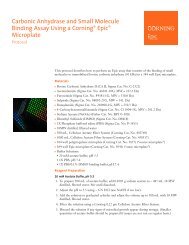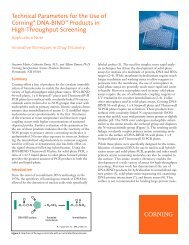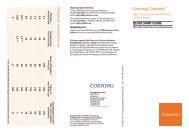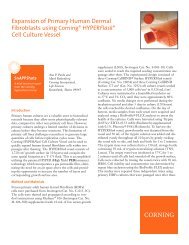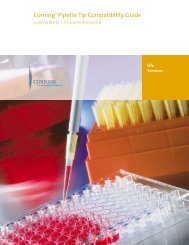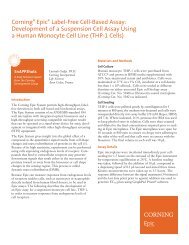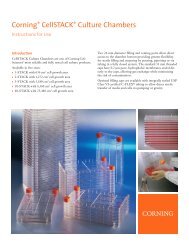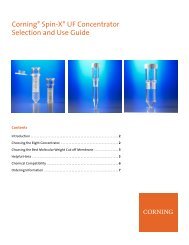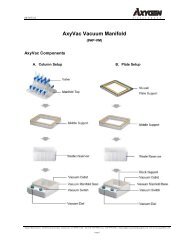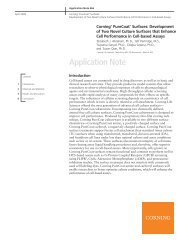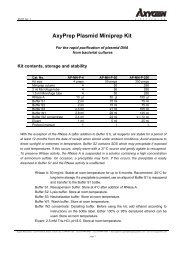Trypsinization Procedure for Corning® Transwell® Inserts CLS-AN ...
Trypsinization Procedure for Corning® Transwell® Inserts CLS-AN ...
Trypsinization Procedure for Corning® Transwell® Inserts CLS-AN ...
Create successful ePaper yourself
Turn your PDF publications into a flip-book with our unique Google optimized e-Paper software.
<strong>Trypsinization</strong> <strong>Procedure</strong> <strong>for</strong> Corning ® Transwell ® <strong>Inserts</strong><br />
Supplies<br />
1. Cell culture medium. This should contain all of the additives (sera,<br />
glutamine, etc.) required by the chosen cell line.<br />
2. Calcium- and Magnesium-Free Phosphate-Buffered Saline CMF-PBS<br />
(10mL). This simple salt solution is used to maintain proper pH and<br />
osmotic balance while the cells are being washed to remove protease<br />
inhibitors that are found in FBS.<br />
3. 0.05% Trypsin/EDTA (0.05%) solution: Trypsin is normally used in<br />
concentrations ranging from 0.05% to 0.25%. Working concentrations are<br />
usually determined by using the lowest trypsin concentration that can<br />
remove the cells from the substrate and give a single cell suspension in a<br />
relatively short time (5 to 10 minutes). Trypsin solutions are often<br />
supplemented with other enzymes (collagenase) or chelating agents<br />
(EDTA) to improve its per<strong>for</strong>mance.<br />
4. 15mL disposable screw cap centrifuge tubes (Corning Catalog # 430055 or<br />
430788)<br />
5. Hemacytometer<br />
6. Centrifuge<br />
7. Phase contrast microscope<br />
8. 1, 5, 10 and 25mL pipettes - Corning Catalog # 4485, 4487, 4488 and 4489
Recommended buffer<br />
and trypsin volumes<br />
6.5mm Transwell insert:<br />
add 0.1ml to the top, 0.6ml<br />
to the well bottom;<br />
12mm Transwell insert:<br />
add 0.3ml to the top, 1.5ml<br />
to the well bottom;<br />
12mm Snapwell insert:<br />
add 0.3ml to the top, 3.5ml<br />
to the well bottom;<br />
24.5mm Transwell insert:<br />
1 add 1.0 ml to the top,<br />
1.5ml to the well bottom.<br />
<strong>Procedure</strong><br />
1. Aseptically aspirate spent media from the bottom well of the plate and from<br />
inside the Transwell ® insert.<br />
2. Rinse the top and bottom of the Transwell insert 2 to 3 times with PBS to<br />
remove any serum (contains trypsin inhibitors). Review chart on left <strong>for</strong><br />
recommended buffer volumes.<br />
3. Add Trypsin/EDTA to the bottom of the well and Transwell insert. Use the<br />
same liquid volumes as above. Incubate <strong>for</strong> 10 minutes in a 37°C<br />
incubator, containing 5% CO 2 .<br />
4. After 5 minutes, view the cells under a phase contrast microscope <strong>for</strong><br />
detachment. Generally, the lower the trypsin concentration and the less time<br />
the cells stay in trypsin the better. Once the cells look rounded or detached<br />
(approximately 10 minutes), remove the Trypsin/EDTA containing cell<br />
suspension and add to a 15mL centrifuge tube containing 5mL of serumcontaining<br />
culture medium to inactivate the trypsin. (For serum-free culture<br />
use a trypsin inhibitor.)<br />
5. With the cover on the plate of the Transwell inserts, sharply hit the side of<br />
the plate with your hand to detach cells from the membrane. Rinse the top<br />
and bottom of the Transwell insert with Trypsin/EDTA to remove any<br />
remaining cells. Add the cell suspension to the centrifuge tube.<br />
6. Observe Transwell inserts under a phase contrast microscope to ensure that<br />
all of your cells have been removed. Per<strong>for</strong>m a second trypsinization if<br />
there are large numbers of cells still remaining on the membrane by<br />
repeating the steps 3 to 5.<br />
7. Gently vortex the cells to resuspend and then remove an aliquot of cell<br />
suspension and count with a clean hemacytometer. Centrifuge cells <strong>for</strong> 5 to<br />
10 minutes at 100xg. Remove media from the centrifuge tube, leaving the<br />
cell pellet, and resuspend cells in the appropriate amount of growth media.<br />
For additional product or technical in<strong>for</strong>mation, please visit our web site at<br />
www.corning.com/lifesciences or call 1-800-492-1110. International<br />
customers can call 978-635-2200.<br />
Corning Incorporated Worldwide India Taiwan United Kingdom<br />
Life Sciences Support Offices t 91 11 341 3440 t 886 2-2716-0338 t 0800 376 8660<br />
f 91 11 341 1520 f 886 2-2716-0339 f 0800 279 1117<br />
45 Nagog Park ASIA<br />
Acton, MA 01720 Japan EUROPE LATIN AMERICA<br />
t 800.492.1110 Australia t 81 (0) 3-3586 1996<br />
t 978.635.2200 t 61 2-9416-0492 f 81 (0) 3-3586 1291 France Brasil<br />
f 978.635.2476 f 61 2-9416-0493 t 0800 916 882 t (55-11) 3089-7420<br />
Korea f 31 20 659 7673 f (55-11) 3167-0700<br />
www.corning.com/ China t 82 2-796-9500<br />
lifesciences t 86 21-3222-4666 f 82 2-796-9300 Germany Mexico<br />
f 86 21-6288-1575 t 0800 101 1153 t (52-81) 8313-8586<br />
Singapore f 0800 101 2427 f (52-81) 8313-8589<br />
Hong Kong t 65 6733-6511<br />
t 852-2807-2723 f 65 6735-2913 The Netherlands<br />
f 852-2807-215 t 31 (0) 20 655 79 28<br />
f 31 (0) 20 659 76 73<br />
<strong>CLS</strong>-<strong>AN</strong>-033W<br />
Corning and Transwell are registered trademarks of Corning Incorporated, Corning New York<br />
Snapwell is a trademark of Corning Incorporated, Corning New York 4/03



